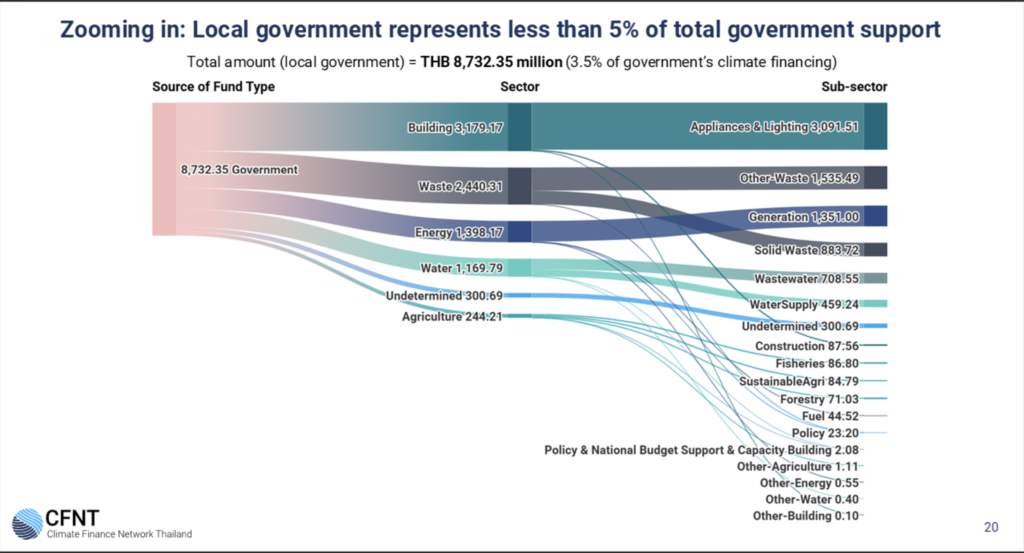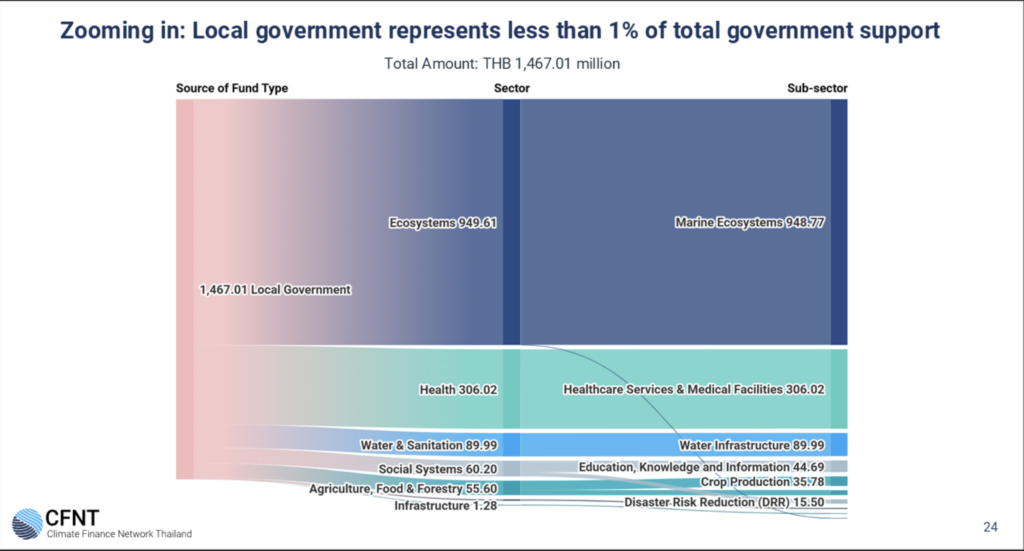
At the ‘Mobilizing Climate Finance for a Climate Resilient Bangkok’ event hosted by Climate Finance Network Thailand (CFNT) on 30 September 2025 during Bangkok Climate Action Week, CFNT presented new findings from Thailand’s climate finance landscape. It included detailed insights into how local governments across Thailand are investing in climate action—and the growing risks the country faces due to climate change.
As Thailand continues to grapple with intensifying climate impacts, a key question arises: How is Bangkok and other local governments allocating their budgets to address climate change, and how far are we from meeting the country’s climate finance goals?

Bangkok’s Climate Change Risks
Thanida Lawseriwanich, Head of Research at CFNT, began the presentation by sharing data from Swiss Re’s risk assessment, which projects that if global temperatures rise to 2–2.6°C by 2048, Thailand could lose around one-third (33.2%) of its GDP. In the worst-case scenario, with temperatures increasing to 3.2°C, the country’s economic loss could reach 43.6% of GDP.
Thailand has shown commitment to addressing climate change—especially in emissions mitigation. The country recently revised its Net Zero target under the Nationally Determined Contribution (NDC) from 2065 to 2050. However, efforts toward climate adaptation and resilience-building remain limited. The Thailand National Adaptation Plan (NAP), though recently launched, still lacks clear operational pathways and actionable measures at the local level.
The Thai capital of Bangkok, in particular, is facing the following four key challenges in terms of climate change vulnerability:
- Heat Stress – Rising temperatures, rapid urban expansion and the loss of green spaces have caused Bangkok’s average temperature to rise by 5.26°C over the past 25 years and contribute to more than 2,300 heat-related deaths annually, alongside worsening air pollution and commuting challenges.
- Flooding – More intense rainfall with 737 identified flood-prone zones, Bangkok faces one of its most pressing and costly climate impacts. By now, during peak traffic hours, congestion in 16 major intersections can result in over 2,000 additional travel hours delayed per day.
- Erosion – Sea level rise has already caused Thailand to lose 26% of its 3,151-kilometer coastline, including 2,735 rai of coastal land in Bangkok’s Bang Khun Thian district.
- Land Subsidence. Exacerbated by excessive groundwater extraction, coupled with the city’s naturally soft soil
How Are Local Governments Funding Climate Action?
Data from Thailand’s Climate Finance Landscape shows that between 2018 and May 2025, Thailand invested around THB1.7 trillion baht in mitigating greenhouse gas emissions. Meanwhile, between 2020 and 2024, the country spent only THB148.1 billion baht on climate adaptation.

Zooming in Provincial Administrative Organization (PAO) budget across Thailand (including some of Bangkok’s projects), the data reveal that local administrations spent only THB8.73 billion baht—around 3.5% of total public investment—on greenhouse gas mitigation projects. The top three investment areas were:
- Energy production, especially waste-to-energy projects (THB1.26 billion; 14.42%)
- Energy efficiency, particularly building appliance and lighting (THB335.74 million; 3.85%)
- Waste management, mainly of solid waste (THB287.43 million baht;3.30%)

In terms of climate adaptation, based on data collected jointly by CFNT and the Puey Ungphakorn Institute for Economic Research (PIER), Thai local governments invested THB1.47 billion, or less than 1% of total public spending. The top three areas were:
- Marine ecosystem, especially mangrove plantation for coastal erosion prevention (THB949 million; 64.69%)
- Healthcare and medical services, particularly for the prevention of emerging and contagious diseases (THB306 million; 11.80%)
- Education, knowledge and information, such as capacity building for adaptation and resilience (THB44.69 million baht; 3.05%)
According to updated data shared by Bangkok Metropolitan Administration (BMA) during the launch of CFNT’s Thailand Climate Finance Tracker on 21 July 2025, the city allocated a total of THB20.24 billion baht (around 22% of its annual budget) in 2025 to address climate change. This includes:
- THB13.14 billion for climate mitigation finance
- THB6.27 billion for climate adaptation finance
- THB470 million baht for climate impact prevention
CFNT will continue coordinating with the BMA to integrate this information into the Thailand Climate Finance Tracker database.
📊 Read Bangkok’s presentation at the Thailand’s Climate Finance Landscape launch: https://shorturl.asia/0nLwK

How Far Is Thailand from Its Climate Finance Goals?
The Department of Climate Change and Environment (DCCE), under the Ministry of Natural Resources and Environment, estimates that Thailand needs at least THB10.3 trillion in additional investment to meet its greenhouse gas reduction targets.
Meanwhile, the International Monetary Fund (IMF) estimates that Thailand requires THB192 billion baht per year for adaptation and climate-resilient infrastructure across public and private sectors.
Failure to meet this target could cost the country as much as 1 trillion baht annually, according to DCCE projections.
While these figures highlight Thailand’s significant climate finance gap, the data and discussions emerging from the CFNT’s Thailand climate finance landscape presentation indicate that Thailand is not standing still—but moving forward in addressing the climate crisis.
Download presentation materials:
Explore full data, methodology, and research details on the Climate Finance Tracker: https://climatefinancethai.com/tracker/
📎 Read more findings from Thailand’s Climate Finance Landscape: https://shorturl.asia/z6TEn
